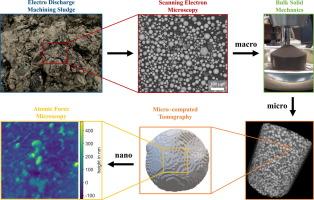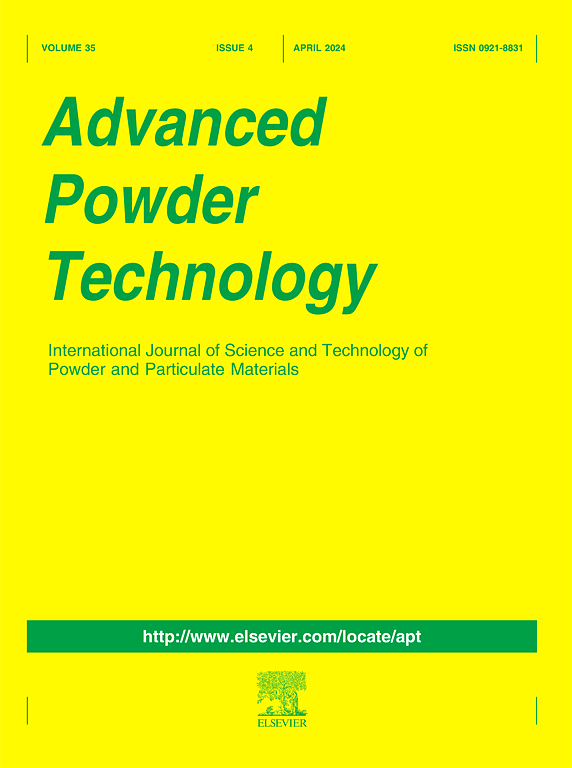Flowability, shape and structure characterization of recycled particles originating from electro discharge machining of H11 alloy
IF 4.2
2区 工程技术
Q2 ENGINEERING, CHEMICAL
引用次数: 0
Abstract
There is a need in metal powder manufacturing to provide alternative supplies because the only production method is the energy– and cost–intensive melt atomization. The aim of this study is focused on recycling of metallic particles originating from electro discharge machining. Extracted particles from accumulating erosion sludges fulfill theoretically specifications of powders regarding particle size and shape. Two fractions were analyzed via laser diffraction, image analysis and electron microscopy and compared to the benchmark H11–alloy. Bulk properties were measured and powders were investigated in a powder shear cell regarding flowability. These properties were combined with measurements of particle surface roughness in an atomic force microscope. Powders were examined by micro–computed tomography to obtain particle–discrete data. Recycled particles fulfill requirements regarding size, shape and defects. Their bulk properties align with the reference, showing improved or worsened flowability at certain stresses. Attached graphite in recycled fractions is acting simultaneously as nano–roughness and flow additive. H11 shows an expected flow behavior, and the coarse fraction the smoothest surface. Results of sphericity values cannot support findings for roughness and flowability. Pores within particles are least present for H11, hence recycled fractions have better pore performance compared to literature.

H11合金电火花加工再生颗粒的流动性、形状和结构表征
金属粉末制造需要提供替代供应,因为唯一的生产方法是能源和成本密集的熔体雾化。本研究的目的是集中在回收金属颗粒产生的电火花加工。从积累的侵蚀污泥中提取的颗粒在粒度和形状方面理论上满足粉末的要求。通过激光衍射、图像分析和电子显微镜对两组分进行了分析,并与基准h11合金进行了比较。测量了粉末的体积特性,并在粉末剪切室中研究了粉末的流动性。这些特性与原子力显微镜下粒子表面粗糙度的测量结果相结合。粉末通过微计算机断层扫描获得颗粒离散数据。回收的颗粒在尺寸、形状和缺陷方面都满足要求。它们的总体特性与参考材料一致,在一定应力下表现出改善或恶化的流动性。再生馏分中附着石墨同时起到纳米粗糙度和流动添加剂的作用。H11表现出预期的流动行为,粗组分表面最光滑。球度值的结果不能支持粗糙度和流动性的结果。H11颗粒内部孔隙最少,因此与文献相比,再生馏分具有更好的孔隙性能。
本文章由计算机程序翻译,如有差异,请以英文原文为准。
求助全文
约1分钟内获得全文
求助全文
来源期刊

Advanced Powder Technology
工程技术-工程:化工
CiteScore
9.50
自引率
7.70%
发文量
424
审稿时长
55 days
期刊介绍:
The aim of Advanced Powder Technology is to meet the demand for an international journal that integrates all aspects of science and technology research on powder and particulate materials. The journal fulfills this purpose by publishing original research papers, rapid communications, reviews, and translated articles by prominent researchers worldwide.
The editorial work of Advanced Powder Technology, which was founded as the International Journal of the Society of Powder Technology, Japan, is now shared by distinguished board members, who operate in a unique framework designed to respond to the increasing global demand for articles on not only powder and particles, but also on various materials produced from them.
Advanced Powder Technology covers various areas, but a discussion of powder and particles is required in articles. Topics include: Production of powder and particulate materials in gases and liquids(nanoparticles, fine ceramics, pharmaceuticals, novel functional materials, etc.); Aerosol and colloidal processing; Powder and particle characterization; Dynamics and phenomena; Calculation and simulation (CFD, DEM, Monte Carlo method, population balance, etc.); Measurement and control of powder processes; Particle modification; Comminution; Powder handling and operations (storage, transport, granulation, separation, fluidization, etc.)
 求助内容:
求助内容: 应助结果提醒方式:
应助结果提醒方式:


